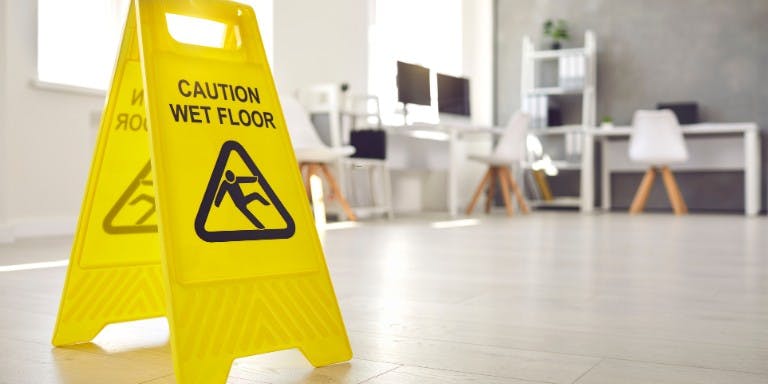First published on Thursday, June 4, 2020
Last updated on Thursday, September 18, 2025
As an employer, the health and wellbeing of your staff is essential. It’s your responsibility to monitor and control any hazards in the workplace.
You must understand what workplace hazards are, and how to ensure your workplace is safe. The last thing you need is a heavy fine following an accident which was completely avoidable.
In this article, we’ll explain the different type of work hazards, how to identify them and, how to undertake workplace risk assessments.
What is a hazard in the workplace?
To make your workplace safe, you need to know what make things hazards. Potential hazards in the workplace is anything that could be a source of harm to someone’s health.
Typically, types of hazards in the workplace are split into six groups:
- Chemical: Use of dangerous substances that could cause health issues to employees.
- Biological: Any potentially harmful bacteria or viruses.
- Physical: Any environmental factors that could cause a risk to your employees, for example air quality.
- Workload: A high workload could cause stress and further health issues.
- Ergonomic: Any issues regarding manual handling, desk positions or standing for long period.
- Safety: Any slips or falls, and the operation of dangerous machinery or electrical equipment.
Common workplace hazards
There are a range of occupational hazards which you need to be aware of. The below are a few examples of hazards in the workplace:
- Repeating the same movements for a long period of time, especially if causing vibrations.
- Working near motorized vehicles with a risk of being hit.
- Slipping or tripping on a spilt drink, piece of equipment or loose carpet.
- Working on heavy or extremely loud machinery.
- Loose electrical wires.
- Pest infestation.
- Working at height.
You must understand the importance of environmental hazards in the workplace. Environmental hazards may take longer to manifest but will do the most damage to your employee’s health.
Extreme temperatures, air or noise pollution and radiation can all lead to serious health issues such as cancers or respiratory issues. It’s your responsibility to provide adequate ventilation for your employees and customers.
You must undertake environmental assessments to make sure your workplace stays within the Canadian legal limits.
How to identify hazards in the workplace
When identifying hazards in the workplace, you need to be proactive. Walk around your site and conduct a workplace inspection, make certain you check the following:
- Observe and take note of how employees use equipment and perform tasks.
- Inspect any equipment and machinery being used on site, check manufacturer instructions and safety data sheets.
- Analyze the layout of your site and what difference this makes to hazards.
- Inspect any safety data sheets for potentially harmful chemicals and substances.
- Review your employee incident records, look out for any patterns or if the same piece of equipment is being mentioned frequently.
- Communicate with your employees to see if they have encountered any potential hazards whilst they have been working.
You can also undertake a workplace risk assessment in order to spot any risks in the workplace and ensure your employees remain safe.
What is a workplace risk assessment?
Workplace risk assessments are used to spot and manage any risks associated with hazards. Risk assessments are important to you as they should make up part of your occupational health and safety program.
Take the following steps when performing your risk assessment:
- Walk around your site and identify any potential hazards.
- Determine the likelihood in which the hazard could cause harm.
- Put in place any actions needed to eliminate or control the overall risk.
- Evaluate to confirm if the hazard has been eliminated or controlled.
- Make sure you document the processes you took when eliminating or controlling the risk.
Get help with workplace hazards today with BrightHR
Keeping your employees safe from hazards in the workplace is extremely important.
Carrying out workplace risk assessments will keep your workplace as safe as possible. Not keeping your staff safe can land you in legal trouble.
BrightHR has a range of tools that can help keep your workforce safe. Our BrightSafe online health and safety software allows you to manage your hazard management and record any hazards.
Contact us on 18882204924 or book a demo today.
Have a question?
Ask away, we’ve got lightning fast answers for Canadian business owners and employers powered by qualified experts.

